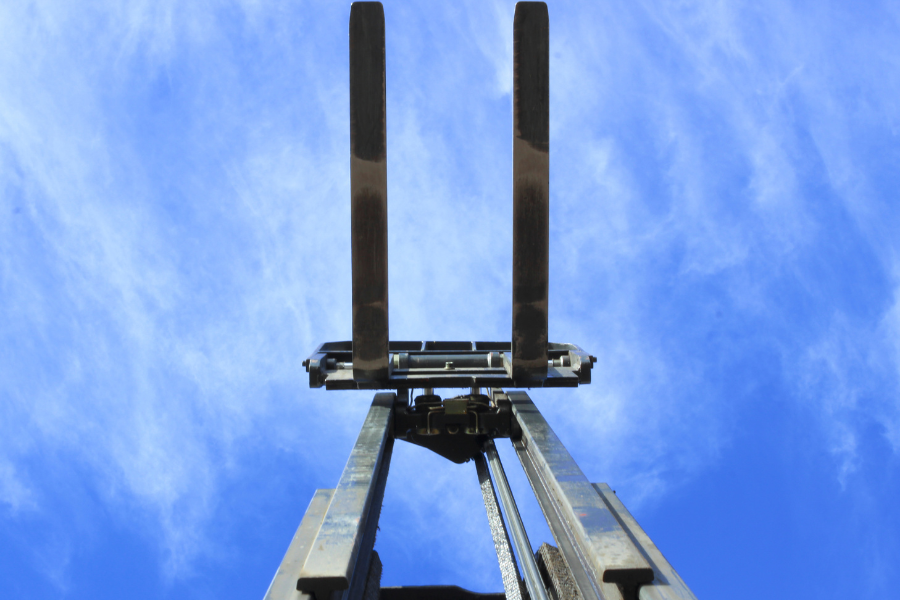The modern forklift is an impressive machine with several technological advances. Yet, inarguably, the most important feature of a lift truck is the forks. Different types of forks adapt to different tasks, which is why the forks are not welded directly to the truck. Instead, they attach to support platforms known as forklift carriages.
What is a forklift carriage?
Forklift carriages are located on the front of most forklifts attached to the mast. A forklift’s mast, also known as an upright, is the vertical component that controls the raising, lowering and tilting of a load.
The main feature of most forklift carriages is two thick metal bars known as forklift carriage bars or pallet fork carriage bars. There is an upper and a lower carriage bar with a standardized amount of space between them (see below). Every component used to secure a load connects to the forklift carriage, including the forks, load backrest and any accessories.
Likely, you’re familiar with the forks, which are also known as tines. They make direct contact with a load by lifting it off the floor. The load backrest allows a pallet or other cargo to rest securely against a forklift without interfering with the many moving mechanisms of the mast. Not every lift truck has a forklift accessory, but when they do, it is typically to accomplish a specific task, such as a paper roll clamp or a slip-sheet attachment.
Forklift fork and carriages dimensions and specifications
There are five forklift carriage classes determined by the machine’s potential lifting capacity. Knowing your exact carriage forklift class is essential because forks and forklift attachments are designed to work with the dimensions of specific forklift carriages.
The five forklift carriage classes are:
Class 1
Carriage height: 13 inches
Lifting Capacity: Less than 2,200 pounds
Class 2
Carriage height: 16 inches
Lifting Capacity: Between 2,200 and 5,500 pounds
Class 3
Carriage height: 20 inches
Lifting Capacity: Between 5,500 and 10,998 pounds
Class 4
Carriage height: 25 inches
Lifting Capacity: Between 11,000 and 17,600 pounds
Class 5
Carriage height: 28.66 inches
Lifting Capacity: Between 17,602 and 24,198 pounds
While there is no standard forklift carriage width (or, more accurately, there are five), most warehouse forklifts have class 3 or class 2 forklift carriage dimensions. If you are uncertain about your lift trucks’ exact carriage class, you can find out by measuring the bars and the distance between them. Remember, when measuring, you want to include the entire width of both carriage bars and the space between them.
Please note that while forklift carriage classes provide a reliable indication of a forklift’s lifting ability, you should always refer to the forklift data plate for specific load capacity information.
Hook-type vs. pin-type forks
Another important aspect of different forklift carriage types is how the forks attach. There are two broad classifications for forklift mounts: hook and pin.
Hook-type forks
Also known as clips, hangers or ITA-style forks, hook forks are the most common fork used today. All forks are L-shaped, and the horizontal portion is the longest and what most people think of when they picture a forklift. The vertical portion is shorter on hook-type forks and has two metal hooks welded to the back. To attach, position the top hook securely to the upper carriage bar. Next, fit the lower hook into a slot cut from the lower carriage bar. Finally, slide the fork to one side to complete the installation.
The position of the hooks corresponds precisely to the distance between the upper and lower forklift carriage bars. For example, all class 2 hook-type forks work with class 2 forklift carriage dimensions regardless of manufacturer. However, a class 3 hook-type fork will not work with a class 2 forklift carriage.
Pin-type forks
Also known as shaft-mounted forks, pin-type forks are typically used on telehandlers, wheel loaders, forklifts with a 15,000-pound or more lift capacity and older forklifts. Instead of hooks on the back of the vertical portion, pin-type forks end in a hollow circle or a hook. Both types also have a small hole at the top to accommodate a locking pin.
To attach, either slide the circle onto a round bar located on the forklift carriage or hook the fork over the carriage. Once the fork is on the carriage, a locking pin secures the fork by lodging into a notch on the carriage bar. Some pin-type forks are telescopic so they can extend to various lengths. Because there is no standardization for pin-type forks, most need to be custom ordered.
At Texas Motive Solutions, we help Texas warehouse operators keep their forklift fleets running efficiently and on schedule. If you have any forklift questions, especially about forklift batteries and accessories, please give us a call at (888) 316-2459 or fill out a form to learn more about our services.



